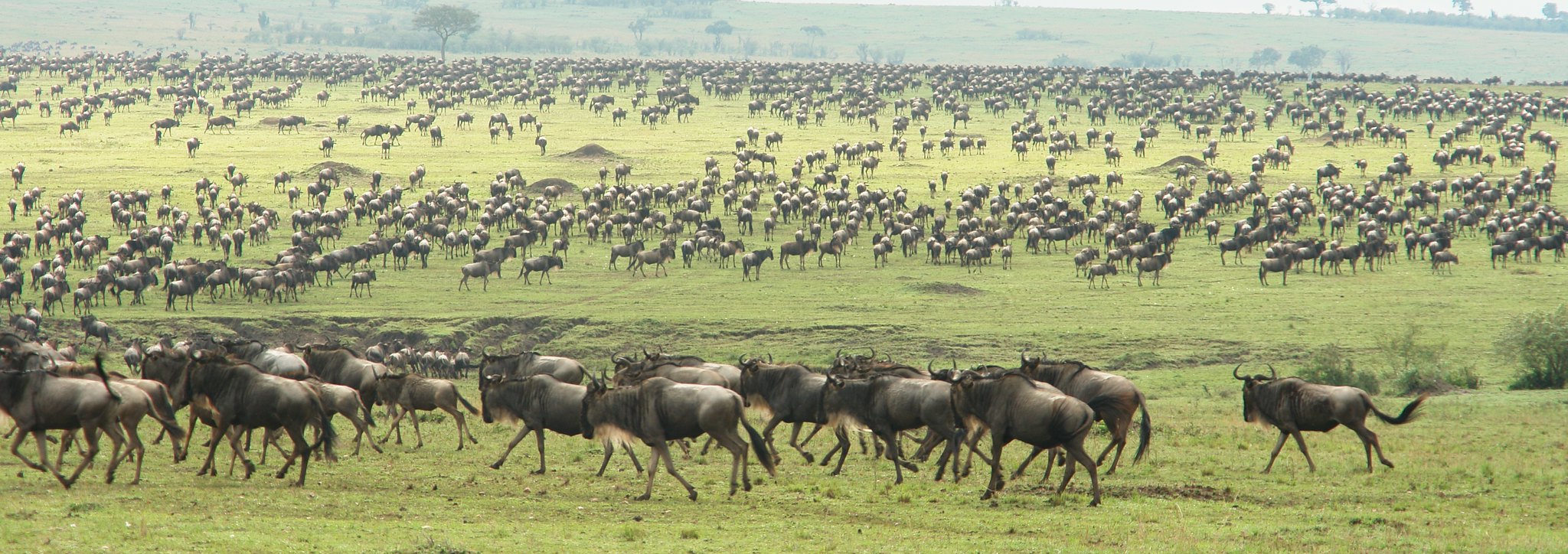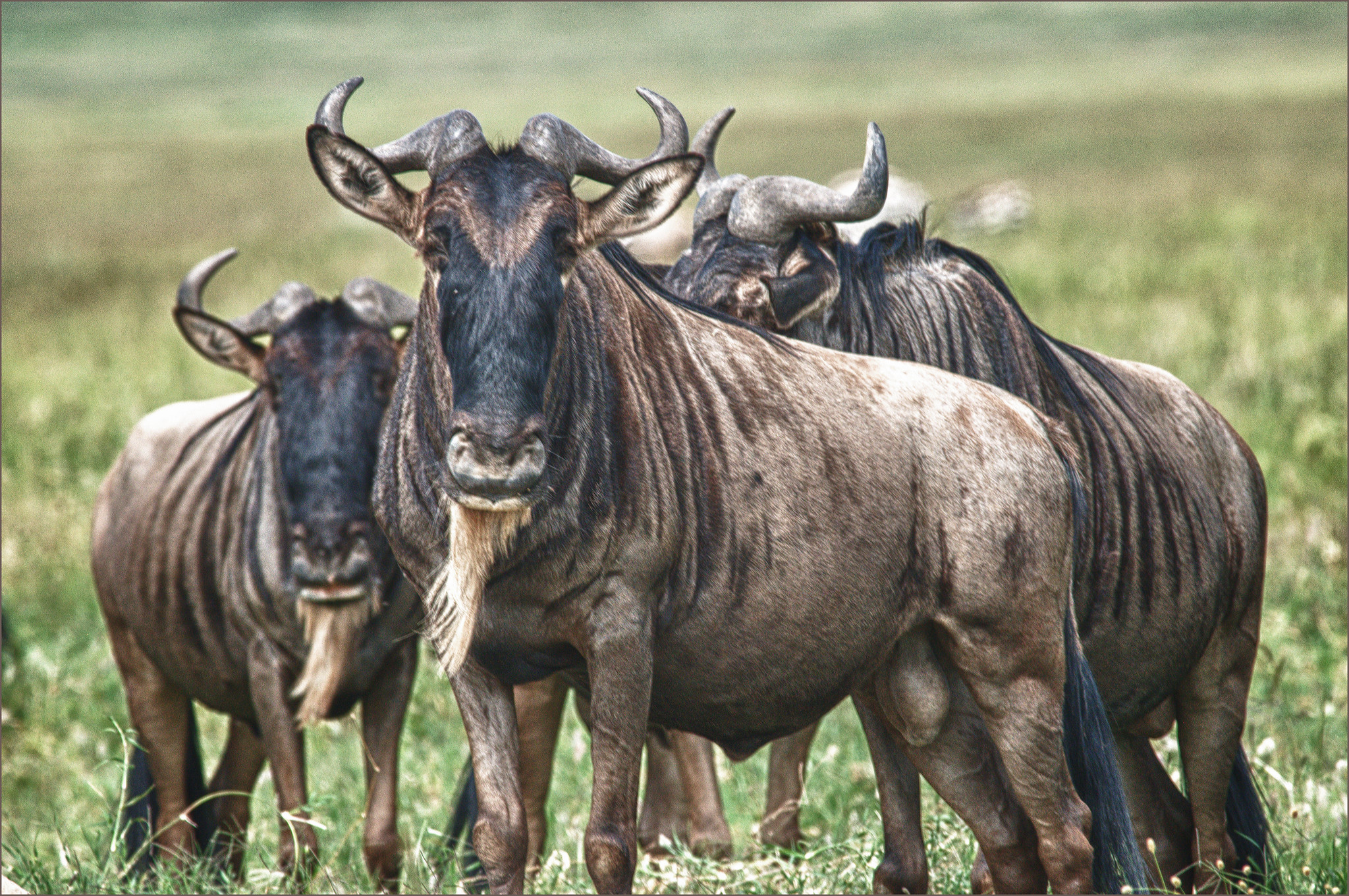10 Fun Facts About Wildebeests
The wildebeest is a well-known animal in the African plains. There are about 1.3 to 1.7 million wildebeest in the famous Serengeti National Park. They are the world’s biggest herd of herbivores. Here are the 10 Fun Facts About Wildebeests.

10 Fun Facts About Wildebeests
1. Two kinds of wildebeest live in the world.
The antelope family is home to the wildebeest. They only live in the southern, northern, and eastern parts of Africa. The black wildebeest, also known as the white-tailed gnu, and the blue wildebeest, also known as the brindled gnu, are the two species. It’s mostly just the color and direction of their horns that make them look different.
There are five types of blue wildebeest: albojubatus, cooksoni, johnstoni, mearnsi, and taurinus. The black wildebeest, on the other hand, is a single species.
2. Their name comes from the Dutch who lived there.
The word “wildebeest” comes from the Dutch language. It comes from the Afrikaans words for “wild beast” or “wild ox,” which is how the settlers in South Africa first thought of these animals when they saw them around 1700.
The formal name for this group of animals, Connochaetes, comes from the Greek words for “beard” (kónnos) and “mane” (khaítē), which perfectly describe how they look. Wildebeests have big heads, bushy beards, and rough skin.
They both have sharp horns that stick out to the side and turn inward.
3. Wildebeest propel the migration.
Many people know that wildebeests play a big part in the epic journey. Every year, this event takes place on a trip that is both dangerous and amazing. In search of new food and water, big groups of wildebeest and other animals move across the Serengeti and the Maasai Mara. The migration follows an ancient route that is deeply ingrained in the animals’ instincts.
The migration is more than just animals moving around; it’s a major event that changes the whole environment of the savanna. The wildebeests’ journey affects the lives of many other animals as well. Lions and hyenas depend on the groups for food, and scavengers get food from the dead animals. The movement also helps spread seeds and move nutrients around, which is beneficial for the grasslands’ health. In this way, the great migration is an important part of the savanna’s biological and ecological systems.
Keep in mind that not all wildebeest move. For example, the animals that live in the Ngorongoro Conservation Area in northern Tanzania don’t move around much.
4. Wildebeests want to run fast and last a long time.
Even though they look a bit awkward, wildebeests are built for speed and durability. They are excellent at avoiding danger because they can run up to 50 mph (80 km/h). Because they are big and strong, they can get away from animals that want to eat them. They can go long distances quickly and easily, and running doesn’t take any more energy from them than walking.
In addition, wildebeests have developed traits that help them do well in the harsh conditions of the prairie. Their digestive system works very well, so the grasses they eat give them all the minerals they need. They need to be this efficient to keep their energy up, especially when they are migrating or breeding.
5. Wildebeests give birth at the same time
When the wildebeest give birth is a very well-timed event. About 80% of wildebeest babies are born in a short time at the start of the rainy season. This timing gives the calves the best chance of surviving by making predators weaker through sheer numbers. It also ensures calves are born when there is enough grass for the nursing mothers.
During the peak of the birthing season, about 8,000 wildebeest babies are born every day. When they are born, these calves weigh between 44 and 49 pounds, and they can run in just two minutes!
6. It’s important that they eat grass
Wildebeests eat plants for the most part. Their muzzles are blunt, and their front teeth are wide, so they can eat short, thick grasses. This simple food is beneficial for the environment. Their grazing habits keep grasslands from getting too big, which is beneficial for wildlife. This is especially helpfulThis is particularly beneficial in areas where rapid grass growth necessitates slowing down to maintain a balanced environment.t more than 4000 tons of grass.
The way that wildebeests eat affects where and how other species live and behave. When wildebeests graze in certain places, they change the resources that other herbivores can use. Because they are seeking food, they move around a lot, which helps spread nutrients across the grassland. So, wildebeests’ eating habits are critical to how the grassland works.
7. Water is important for wildebeest
Many wildebeests depend on water for survival, which affects how they move from one place to another. Some grassland species can live with little water, but wildebeests need to be able to get to water sources often. Because of this need, they start their great journey, searching for places with enough water and new grass to graze.
Every day or two, the blue wildebeest drinks 9 to 12 liters of water.
8. They are important to the hunter-prey relationship
Wildebeests are an important part of the savanna’s predator-prey system. Many different animals can live with them. Wildebeests are easy prey for lions, leopards, cheetahs, hyenas, and crocodiles during the journey. An important part of the savanna’s natural balance is this connection. The dynamic controls the numbers of predators and food and keeps the ecosystem stable.
The Mara River kills or drowns about 6,250 wildebeests every year, according to a study. Another 250,000 people perish during the journey due to predators, inadequate food, illness, or exhaustion.
9. Wildebeests get information from groups.
The wildebeest like to be with other animals and often live in groups of tens of thousands. They talk a lot, but they also use smell and sight to talk. They use grunts and moans as signs to help the herd stay together.
Wildebeests use swarm intelligence, which is a way for groups to learn and make decisions together using self-organized, unstructured systems. The idea is about how the different people in a group connect with each other and their surroundings, which leads to smart group behavior. This phenomenon is commonly observed in fish, birds, ants, and bees.
Wildebeest herds can travel long distances, find water and food, and stay away from danger even though they don’t have a single boss. People are able to work together because they follow simple rules, like moving toward places with more members and aligning with their neighbors. Individual wildebeest, for example, learn from the actions of others when crossing rivers. They watch what other animals do and copy what they do. This shared learning lowers the risks for each person and raises the group’s chances of success.
10. There is a long history of wildebeests
When it comes to antelopes, wildebeests are one of the oldest species. It took millions of years for them to evolve. Blue wildebeests began to change at least 2.5 million years ago, and black wildebeests became a different species about 1.5 million years after the blue ones. Their unique features, like their big front legs and sloped backs, are the result of evolution that has helped them survive in their environment.
Similar to current wildebeests, Rusingoryx atopocranion is an extinct species. Fossils found in Lake Victoria, Kenya, are the main way scientists know it lived during the Pleistocene period. The strange shape of Rusingoryx’s nose is one of its most noticeable traits. It had a hollow nasal dome that looked like a horn, similar to some dinosaurs. The nasal dome is believed to produce low-frequency sounds for conversation.
Those are the 10 Fun Facts About Wildebeests.
Quick Facts About Wildebeest
- Blue wildebeest is known as Connochaetes taurinus, and black wildebeest is known as Connochaetes gnou.
- Animal Names: Wildebeest, Gnu
- Size: About 4 to 5 feet tall at the shoulder and 6 to 8 feet long;
- Between 260 and 600 pounds
- Ten to twenty years in the wild
- Herbivore, mostly plants for food
- It lives in grasslands and savannas in eastern and southern Africa.
- The Blue Wildebeest is considered least concerned, and the Black Wildebeest is near threatened.
Join us on a tour with us to witness these amazing animals in their natural habitat.


















